 |
 |
|
|
Chronology 1951 - 1962
An artistic life divided between Cuba and Paris (1951 – 1957). February 1951 marked the inauguration of mural paintings by Lam, Amelia Pelaez, René Portocarrero, Carlos Enriquez, Jorge Rigol, Carmelo Gonzales Iglesias and Enrique More, commissioned by the Esso Standard Oil Company (in the Velado district) to adorn their offices. At the occasion, Lam met the journalist and militant anti-government activist Carlos Franqui who would soon preface the catalogue to his solo exhibition in Havana at the Sociedad de Nuestro Tempo gallery. In April, he won first prize at Havana's Salon Nacional de pintura y escultura y Grabado for his painting Composition – a period marked by many awards. His divorce was finalized in May 1951, after which Lam returned to Europe for several months, leaving his house in the care of a Cuban friend, the surrealist-inspired writer and film-maker Edmundo Desnoes and his wife Maria Rosa. During the summer months, his surrealist friends commissioned a design for the frontispiece of their special edition of the new review L'Âge du Cinéma, consecrated to the movement and founded by Adonis Kyron and Robert Benayoun. Among the new artists to join the movement are Jean Schuster, Jean-Louis Bédouin, Michel Zimbacca, and Nora Mitrani. In Europe, his paintings took part in a number of CoBrA events: his participation in the 2nd large international exhibition of experimental art held at the Palais de Beaux-Arts in Liège, Belgium; and his drawings illustrated the September issue of the review CoBrA. Dictatorship and another exile (1952) When Lam returned to Havana, he was disturbed by the political developments on the island after the coup d'état instigated by Batista on March 10, 1952, giving rise, once again, to an army-backed dictatorship with all the repercussions that followed: repression, the end to the constitution, the proscription of political parties, the censorship of the press, the repression of political opponents and an inevitable rise in corruption. Lam decided to leave the "Banana Republic" behind him and to settle definitively in Paris. By late August, he settled in France and began preparing for a personal exhibition in London. He illustrated René Char's aphorisms, collected in A la Santé du serpent. He closely followed the developments of the Phases movement and the creation of its eponymous review directed by Édouard Jaquer, Anne Ethuin and Jean-Louis Bédouin, which brought together such diverse artists as Pierre Alechinsky, Corneille, Götz and Max Walter Svanberg, the common denominator among these very different artists being their adoption of automatic writing in their art. Lam felt an affinity to this movement "without manifesto or fixed theory" or, expressed more poetically, "its modern conception of magic". It adopted the motto, taken from Breton, "toute licence en art" ("any license in art")! 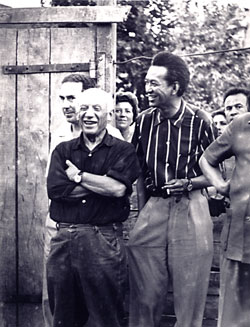
P. Picasso, W. Lam, Vallauris, 1954
In February 1953, Lam was invited to present several paintings to the gallery A l'étoile scellée, which opened the following year with André Breton as artistic director. A collective exhibition, dedicated to Surrealism, brought together works by Ernst, Tanguy, Man Ray, Toyen, Paalen and Lam. Soon after, he met up with Picasso in Mougins where Picasso took him to see a bullfight. Upon his return to Paris, he participated in a number of surrealist gatherings at the Parisian cafe on La Place Blanche. But Lam remained independent in both his artistic and political involvements, and would continue to maintain his independence throughout his artistic career. He joined Césaire every Sunday for afternoons of conversation with a group of friends, hosted by Césaire's Martiniquan friends Dr Auguste Thésee and his wife Françoise. After a Creole meal, their animated discussions were the occasion for Lam to indulge in another of his passions: economics and politics. Lam illustrated other publications: L'Arbre et l'Arme by Dotremont, alongside Alechinsky, Hérold and the Japanese-American sculptor Shinkichi Tajiri, and Le Rempart des brindilles by René Char. He designed the cover for Carte noire by François Valorbe, a collection of poems inspired by the great black jazz musicians. During the summer, Lam received news of the latest developments in Cuba and the armed response by Fidel Castro against Batista. What would come to be called the “Movement of July 26” was a failure: Castro and his comrades, Carlos Franqui among them, were charged with a 15-year prison sentence but would serve their sentence until 1955 before leaving in exile to Mexico where they met Ernesto Che Guevara. In September, Lam went to Italy to exhibit with 12 other artists at the Ecole de Paris, an event organized by Christian Zervos for which Lam won the gold medal of the Lissone Prize, awarded to foreigners, for his large canvas La Fiancée. Times of many travels 1954 – 1961 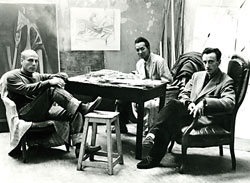
G. Luca, W. Lam, W. Freddie, Paris 1954
In Paris, January 1954, Lam met the young writer and art critic Alain Jouffroy, excluded from the surrealist movement four years prior. He also met, in the Phases circle, the Rumanian poet Gherasim Luca, a friend of Brauner’s and Hérold’s, whose deep voice explored the French language with great originality, precision and anxiety. He had come to Paris in 1952 but remained stateless all his life. Another friendship developed with the Danish painter Wilhelm Freddie, also an exile, whose work created numerous scandals. Lam participated for the first time in the 10th Salon de Mai, to which he would remain faithful for many years to come. This yearly event, founded and organized by Gaston Diehl, Jacqueline Selz and Yvon Taillandier, was conceived in 1943 to give a venue and backing to modern art, and to put up resistance to the Nazi's conception of degenerate art. It took place regularly, beginning in 1945. Asger Jorn and the ceramicist Tulio Mazzotti sent Lam an invitation to participate in the International Meeting of Sculpture and Ceramics scheduled for August, 1954, in Albissola (Italy), a small seaside resort town on the Ligurian coast, known for its history of using terra cotta as early as the Renaissance. Hosted by Jorn and Enrico Baj, the creators of the International Movement for an Imaginary Bauhaus, the meeting brought together artists to work and experiment collectively. Appel, Corneille, Matta, Sergio Dangelo, Édouard Jaguer, among others, were present, but Lam arrived too late. By the time he got there, everyone had left. He nevertheless fell under the charm of the place and promised to return. The indefatigable traveler then took off once again, this time to Havana to discuss plans for an exhibition at the university. In Chicago he was presented to the collectors Edwin and Lindy Bergman, who had already acquired several of his paintings. 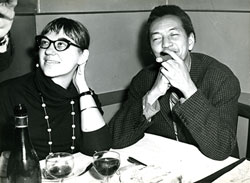
L. Lam, W. Lam, Italie, 1957
In Paris, he found housing at the Cité Universitaire, not far from his painting studio at the Villa Alésia. He stayed in close contact with the surrealists – illustrating the 4th issue of their review Médium – and in particular with Benjamin Péret, who described him as “the African sorcerer and Asian shaman – the two forces joined inside of him in an adventure to extend their powers.” Lam made a series of engravings for the collected poems of the Martiniquan poet Édouard Glissant in La Terre inquiète. In May 1955, he traveled to Caracas for the inauguration of his solo exhibition. He was also invited to the French Venezuelan Institute where its director, Diehl, gave a conference on his work entitled “Rimbaud and Lam.” Carpentier was also present as he was living there in exile. Lam was introduced to the architect Carlos Raul Villanueva, a meeting that led to a commission for a mural painting. Upon his return to Paris in late June, Lam met the young Swedish artist Lou Laurin at the Galerie du Dragon, during an exhibit of Latin-American artists. In September, he went to Sweden and participated in a collective exhibition Imaginisterna at the Colibri gallery which included other artists associated with the CoBrA movement. He took the time to visit the country, in particular Falun where Lou Laurin introduced him to her family. 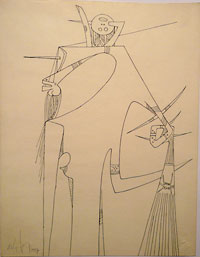
Sans titre, 1957
Immediately following his trip to Sweden, he set off to Caracas, invited by his friend Villanueva, who had built the Ciudad universitaria. Lam had been commissioned to make a large fresco for the botanical gardens. Then in early 1956, in the company of Nicole Raul, he partook in an expedition to the Mato Grosso and had the occasion to fly over the great expanses of virgin forest and the Maroni, Orinoco and Amazon rivers. They spent several weeks in a camp set up by prospectors for gold and precious stones. He caught “the green illness” (a form of chlorosis) and had to return to Cuba for medical care. But he was soon back on his feet, just in time to prepare his exhibition at the university. Before honoring the commission of a large mosaic for the Centro Médico de Vedado, he learned from a letter that Césaire had broken with the Communist Party. In his Lettre à Maurice Thorez of October 24, Césaire expresses his disapprobation of the French Communist Party's sectarianism and refusal to “undertake the path of de-Stalinization.” Lam, always opposed to dogmatism, approved of his friend's reaction. As Lam prepared to leave Cuba, Castro, who had returned to the island undercover, was preparing his offensive with his guerrilla army in the Sierra Maestra Mountains. A solo exhibition opened in February 1957 at the Centro de Bellas Artes in Maracaibo, Venezuela's second largest city, and soon after Lam attended the inauguration of his fresco at the botanical gardens in Caracas. He returned to Europe just before the summer and spent the months of August through September in Italy with Lou Laurin. He met up with Brauner, Manzoni, Baj, Roberto Crippa and Fontana in Milan. During a short stay in Venice, the couple happened to meet Elisa Breton and Jean-Jacques Lebel, as well as Bona and André de Mondiargues, who shared Lam's love of the country and his interest in the occult and magic. They finally returned to Albissola and to their friend Jorn. Jorn had developed intellectual ties with Guy Debord, creating the International Situationist movement. In November, the couple flew to Mexico, arriving in Mexico City the same day as the funeral of the muralist Diego Rivera. Lam met up with one of his oldest Spanish friends Anselmo Carretero, but also the ex-wife of Péret, Remedios Varo, who introduced the couple to Leonora Carrington and the collector Edward Silence. Lam’s friend Carlos Franqui, who had been imprisoned and tortured under the reign of Batista, introduced them to a number of pro-Castro refugees: the doctor Martha Frayde, the union activist Lazaro Pena and Castro's university fellow Alfredo Guevara. Traveling through the country, Lam learned that his sister Eloisa had died. Toward the end of February, the couple left Mexico and returned to Cuba. Lam showed Lou Laurin around Havana, a dynamic and festive city, albeit corrupt. But the repressive climate spelled danger for the Castro guerillas, and a number of the painter's friends were arrested. Mangiargues paid Lam a brief visit on his way through and the surrealist poet José Álvarez Baragaño. Baragaño, who was preparing a monograph on the painter, began interviewing him. Lam decided to leave Cuba, but before leaving he burned several of his large canvases – those he was not entirely satisfied with – while others he put in the care of his sister Augustina. He received news of the birth in Paris of Stéphane, his son with Nicole Raul. On April 9, the day of a general strike, the couple left for Miami, and then New York where a number of their friends awaited them: Jesse Fernández, Carlos Rigaudias, Eugenio Granell.... 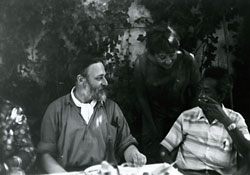
A. Jorn, L. Lam, W. Lam, Albissola, 1963-64
They landed once again in Europe and spent the month of August in Albissola, staying with their friends the Crippas, then Jorn. They then went to Rappallo where Enrico Baj was working with ceramics. Lam was enthusiastic about discovering this new milieu, brimming with friendship and artistic freedom. In Chicago, in October, he was elected as a member of the Graham Foundation for Advanced Studies in the Fine Arts. The city of art collectors, in Chicago there were the Neumanns and the Maremonts (20th century art), Muriel Newmann (American art after 1945), the Bergmans and the Shapiros (surrealist art). Immediately upon his return to Europe, Lam received news from Cuba that the "Movement of July 26" fighters had taken Santa Clara and were about to make a victorious entry into Santiago de Cuba and even Havana. Batista was forced to flee the country. The much hoped-for Cuban Revolution was in full swing. Fidel Castro finally took control on January 8, 1959, and began implementing the sort of reforms Lam and his compatriots had hoped for. But Lam chose not to return to the island like his friend Alejo Carpentier. In Paris, he frequently met with Marcel Zerbib, a publisher and the director of the Galerie Diderot. A chance meeting with Max Ernst and his wife Dorothea Tanning led to a collective project of illustrating the poems of Alain Bosquet in Paroles peintes. Matta and Hérold joined them. Lam participated in documenta II in Kassel. Initiated in 1955 by Arnold Bode, an artist whose work was forbidden during the Nazi regime, the original idea was to reconcile the German public with modern art and to gather together all the vibrant forces of artistic creation in the spirit of multiculturalism. It would take place every five years and last 100 days. In the year of 1959, more than 1800 works from 300 artists were selected. ![La Confidence, II [Les deux sœurs], 1962 La Confidence, II [Les deux sœurs], 1962](../../Img/paintings/62.25_vignette.jpg)
La Confidence, II [Les deux sœurs], 1962
It was not clear whether Lam met the poet and art critic Hubert Juin through Aimé Césaire or through René Char. Juin finished writing a book on Césaire in 1956. Lam would illustrate Juin's current book project to be published in 1960 entitled Le Voyageur de l'arbre. And parallel to this, he made a number of lithographs to "comment," in his own way, the poems of Alain Jouffroy. After the Salon de Mai and an exhibition in Venice from June to July, Lam and Lou Laurin spent another summer in Albissola, before returning to the United States. On November 21, 1960, they married in Manhattan and then made another visit to Chicago, invited this time by Lindy and Edwin Bergman. They were introduced to many other Chicago collectors: Jory and Joseph Shapiro, Claire Ziesler, Ruth and Leonard Horwich, as well as the art dealer Richard Feigen. Undoubtedly their stay was animated by lively discussions about art, but also about the situation in Cuba; although tempered somewhat in lieu of the stand taken by the U.S. government who break off diplomatic relations and set an embargo on Cuban products. Lam was hoping to see the revolutionary regime grow in international scope and, above all, to take the form of a worldwide anti-imperialist movement. Painting and family life 1961 – 1962 After all these years of absence, the Lams were disheartened by the tension that pervaded everyday life in France, following in the wake of its involvement in the Algerian War. As a Cuban, Lam was again confronted with discrimination and decided, instead, to set up his life in Zurich and Albissola. His choice of Switzerland led to a greater appreciation of his graphic work. His engravings were chosen to illustrate Gherasim Luca's poems in L'Extrême Occidentale, alongside works by Arp, Brauner, Hérold, Matta and Tanning. His prints also appeared in L'Oeuvre gravée and were solicited by the Galerie Mathieu. Lam closely followed the events unfolding in Cuba – the failed landing of the Bay of Pigs, backed by the United States and Cuba's decision to receive aid from the Soviet Union. That same year, Chris Marker's documentary Cuba si marked the first anniversary of the Cuban Revolution. The Lam couple rejoiced at the birth of their son Eskil, born in Copenhagen on May 24. The family spent the summer in Albissola and rented a house near their friend Jorn. Encouraged by Jorn, Lam tried his hand at ceramics. Anne Egger (Translation by Unity Woodman) |